Study on Inertia Load Resistance Analysis Method of Light Truck Door Latch
Abstract
:1. Introduction
2. Light Truck Door Latch and Its Inertia Load Resistance Analysis Process
2.1. Working Mechanism of a Light Truck Door Latch
2.2. Light Truck Door Lock Performance Requirements
- (1)
- Longitudinal Load—An automotive door latch and striker assembly, when tested as described under test procedures, must be able to withstand an ultimate longitudinal load of 11,000 N when in the fully latched position and 4450 N when in the secondary latched position.
- (2)
- Transverse Load—An automotive door latch and striker assembly, when tested as described under test procedures, must be able to withstand an ultimate transverse load of 8900 N when in the fully latched position and 4450 N when in the secondary latched position.
- (3)
- Inertia Load—An automotive door latch, when contained in the door latch system (including the door latch, striker assembly, outside handle, key cylinder, and any connecting mechanisms), and in the fully latched position, when evaluated by calculation, must remain in the fully latched position when subjected to an inertia load of 30g in any direction.
2.3. Analysis of Unlocking Causes of Light Truck Door Latch under Side Impact Load
- (1)
- The structures of the fork-bolt, pawl, bottom plate, auxiliary bottom plate, and riveting shaft are greatly deformed or even damaged, which makes the holding function invalid.
- (2)
- The pawl rotates in the unlocking direction until it cannot block the rotation of the fork-bolt so that the fork-bolt cannot lock the striker, and the latch is unlocked and disengaged from the striker, as shown in Figure 5.
2.4. Light Truck Door Latch Inertia Load Resistance Analysis Process
3. Theoretical Calculation of Inertia Load Resistance of Light Truck Door Latch
3.1. Torque Calculation of the Torsion Spring of a Light Truck Door Latch
3.2. Calculation of Force of Light Truck Door Latch Outside Handle
3.3. Force Calculation of Parts of Light Truck Door Latch Outside Opening Kinematic Chain
4. Simulation Analysis of Inertia Load Resistance of Light Truck Door Latch
4.1. Inertia Load Resistance Simulation Model of Light Truck Door Latch
4.2. Simulation Analysis Results of Inertia Load Resistance of Light Truck Door Latch
5. Structural Optimization and Verification of Light Truck Door Latch System
6. Conclusions
Author Contributions
Funding
Institutional Review Board Statement
Informed Consent Statement
Conflicts of Interest
References
- Road Traffic Injuries. Available online: https://www.who.int/news-room/fact-sheets/detail/road-traffic-injuries (accessed on 7 March 2022).
- Qianghong, L.; Sanhong, L.; Lizhi, L. Calculation Method Study on Inertial Load Resistance of Motor Vehicles’ Door Locks. Automob. Technol. 2012, 10, 4–6. [Google Scholar]
- Baohua, D.; Guangxue, D. The design analysis and application of door handle anti-collision capability. Automob. Appl. Technol. 2017, 16, 120–123. [Google Scholar]
- Yunguang, J.; Guangxue, D.; Wei, Z. The Design and calculation of inertia for latch system of automobile. Automob. Appl. Technol. 2017, 8, 123–126. [Google Scholar]
- Guangxue, D.; Xin, W. (Eds.) The Simulation and Optimization for Opening Mechanism of Automobile Side Door Lock Crash Worthiness. In Proceedings of the Annual Meeting of the Society of Automotive Engineers of China (4), Shanghai, China, 22 October 2019. [Google Scholar]
- Chiang, J.Y.; Barber, G.C. Operating effort and related statistical tolerance analyses of automotive latching mechanisms. Int. J. Mater. Prod. Tec. 2002, 17, 353–367. [Google Scholar] [CrossRef]
- Xueming, H.; Lili, S.; Changjiang, X. Failure Mode Analysis and Optimal Design of an Automobile Door Lock. Mach. Des. Res. 2016, 32, 129–133. [Google Scholar]
- Lee, Y.H.; Lee, T.H.; Jeong, H.S.; Yoon, G.H.; Kim, W.H.; Jung, B.D.; Lee, J.B.; Kim, D.B.; Shin, J.Y. Calculation Formula for Operating Force of Vehicle Door Latch: Part 1—Catch, Pawl and Release Lever. Trans. Korean Soc. Noise Vib. Eng. 2020, 30, 37–44. [Google Scholar] [CrossRef]
- Lee, Y.H.; Lee, T.H.; Choi, S.B.; Jeong, H.S.; Yoon, G.H.; Kim, W.H.; Jung, B.D.; Lee, J.B.; Kim, D.B.; Shin, J.Y. Calculation Formula for Operating Force of Vehicle Door Latch: Part 2—OS/IS Lever and Total Force Analysis. Trans. Korean Soc. Noise Vib. Eng. 2020, 30, 45–51. [Google Scholar] [CrossRef]
- Wu, X.C.; Tian, G.H.; Liu, J. Research on Crashworthiness of Car Bumper System. In Proceedings of the 3rd International Conference on Advanced Engineering Materials and Technology (AEMT 2013), Zhangjiajie, China, 11–12 May 2013. [Google Scholar]
- Fei, L.; Shiguo, E.; Xin, Q. CAE Optimization for Rear Door Opening in MDB Side Impact Test for a Vehicle. J. Automot. Saf. Energy 2013, 4, 130–135. [Google Scholar]
- Fang, S. Simulation and Research of Child Restraint System in Rear End Impact and Side Impact. Master’s Thesis, South China University of Technology, Guangzhou, China, January 2016. [Google Scholar]
- Yeom, K.; Ahn, B. A study of side impact test assessment using the side system simulation model. KSAE 2018, 26, 490–495. [Google Scholar] [CrossRef]
- Long, C.R.; Yuen, S.; Nurick, G.N. Analysis of a car door subjected to side pole impact. Lat. Am. J. Sol. Struct. 2019, 16, e226. [Google Scholar] [CrossRef]
- Xiaojie, H.; Lubin, H.; Mingyuan, W.; Xiaobo, H.; Qiansheng, W.; Zhe, L.; Yong, C.; Yong, H.; Jinliang, D. Analysis of Multi-mode Inertial Mechanism of Automotive Door Lock Based on ADAMS. In Proceedings of the International Conference on Robotics, Intelligent Control and Artificial Intelligence (RICAI), Shanghai, China, 20–22 September 2019. [Google Scholar]
- Maria, M.A.; Daniel, I.; Victor-Costin, D.; Cornelia, S. Lateral Impact Behavior Study of a Car Door. In Proceedings of the 4th International Congress of Automotive and Transport Engineering (AMMA), Cluj-Napoca, Romania, 17–19 October 2018. [Google Scholar]
- Hequan, W.; Shijie, K.; Hanbin, H. Research on Application of Electric Vehicle Collision Based on Reliability Optimization Design Method. Int. J. Comp. Methods-Sing. 2019, 16, 1950034. [Google Scholar]
- More, K.C.; Patil, G.M.; Belkhede, A.A. Design and analysis of side door intrusion beam for automotive safety. Thin-Wall. Struct. 2020, 153, 106788. [Google Scholar] [CrossRef]
- Weiwei, W.; Shijuan, D.; Wanzhong, Z.; Chunyan, W.; Tao, M.; Qingyun, C. Reliability-based optimization of a novel negative Poisson’s ratio door anti-collision beam under side impact. Thin-Wall. Struct. 2020, 154, 106863. [Google Scholar]
- Kim, J.Y.; Choi, S.H. Study on the optimization design and impact experiment of side door for impact beam in the vehicle side door. Tribol. Lubr. 2015, 31, 13–20. [Google Scholar]
- Ganessh, T.S.; Bansode, P.; Revankar, V.; Kumar, S. Vehicle performance evaluation in side impact (MDB) using ES-II dummy. In Proceedings of the 1st International Conference on Advances in Metallurgy, Materials and Manufacturing, Salem, India, 6–8 March 2017. [Google Scholar]
- Chuanxing, L.; Gaojun, C.; Chengjing, Z.; Yi, X. Research on the Issue of Rear Door Opening during Side Impact. In Proceedings of the 2020 China Society of Automotive Engineering Annual Conference and Exhibition, Shanghai, China, 27 December 2020. [Google Scholar]
- Chuanxing, L.; Gaojun, C.; Wanli, L.; Yi, X.; Chengjing, Z. Research and Optimization of Deformation Mode of Outer Door Metal under Side Impact Conditions. In Proceedings of the 2021 China Society of Automotive Engineering Annual Conference and Exhibition, Shanghai, China, 19 December 2021. [Google Scholar]
- Cengxiang, W.; Xianying, W.; Xiangzhi, L. Spring Design Manual, 1st ed.; Shanghai Scientific and Technical Literature Publishing House: Shanghai, China, 1986; pp. 259–260. [Google Scholar]
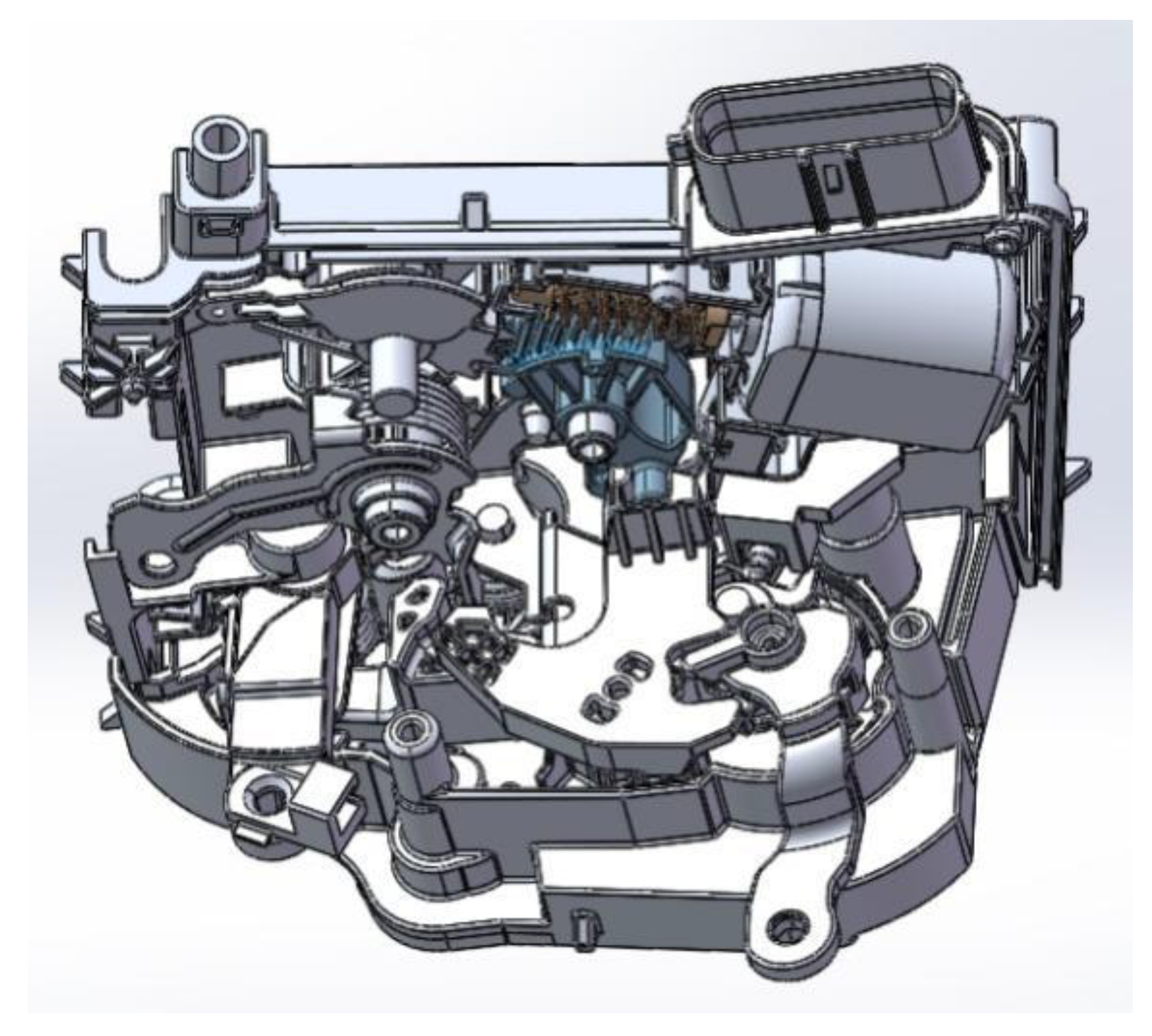

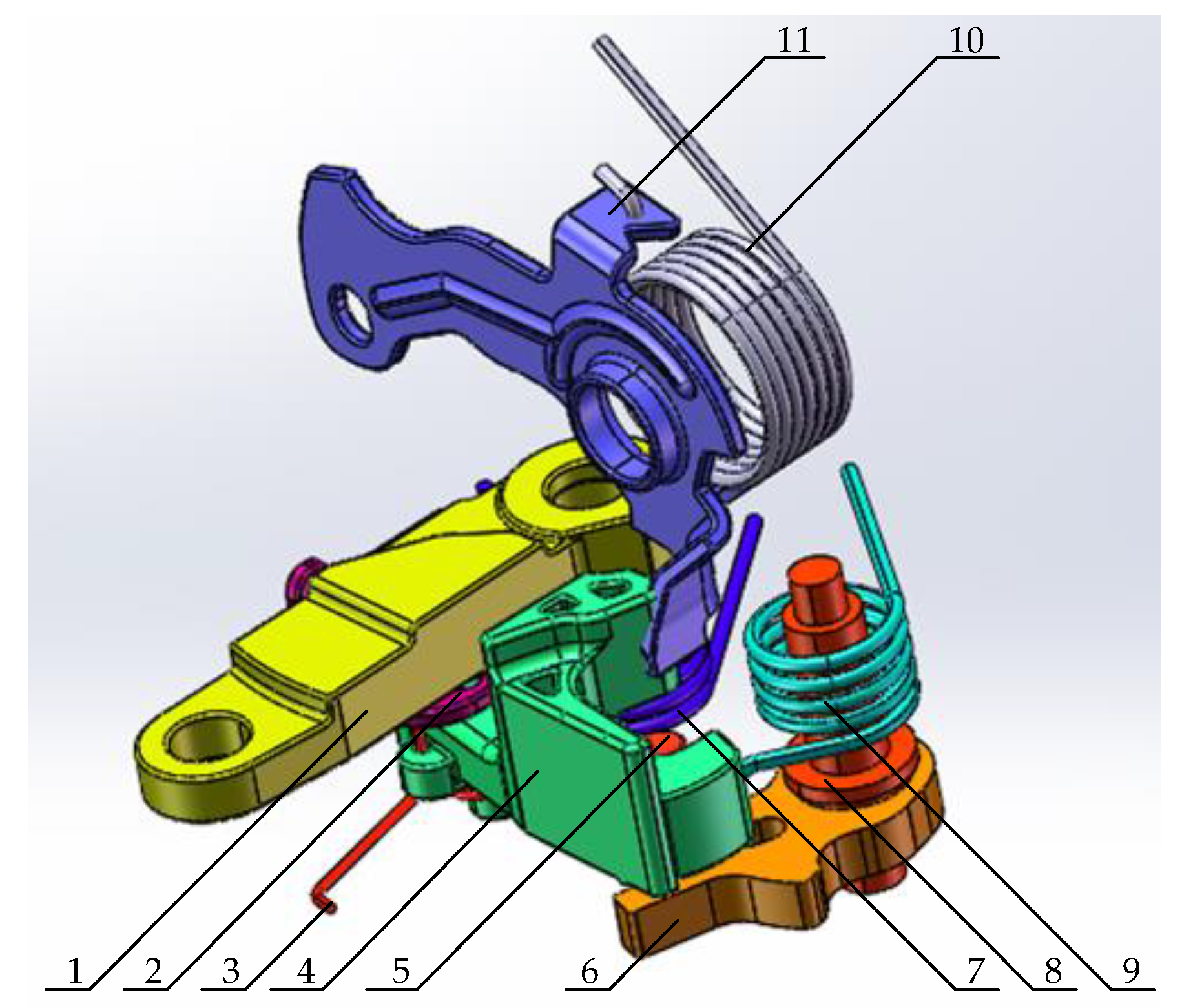

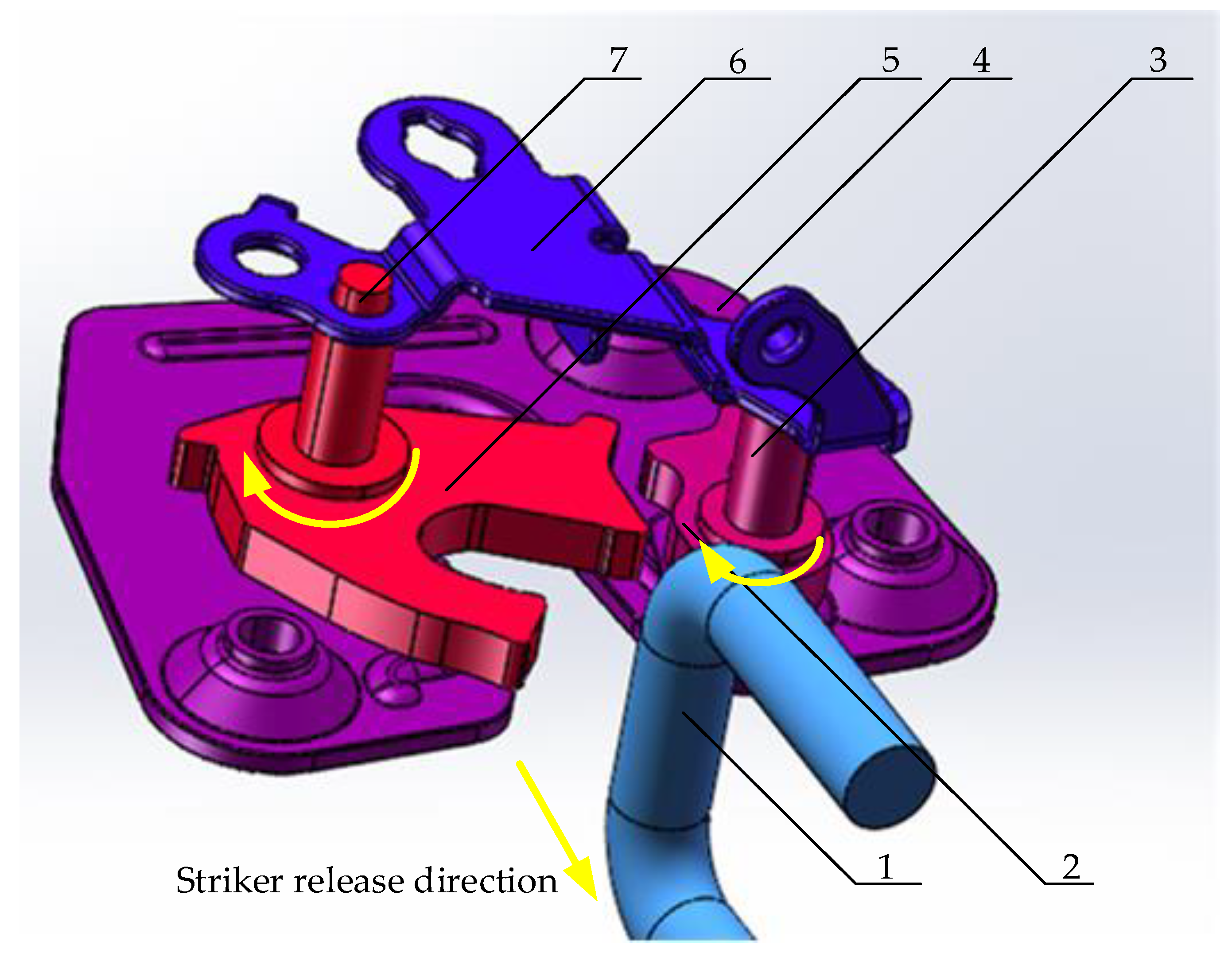
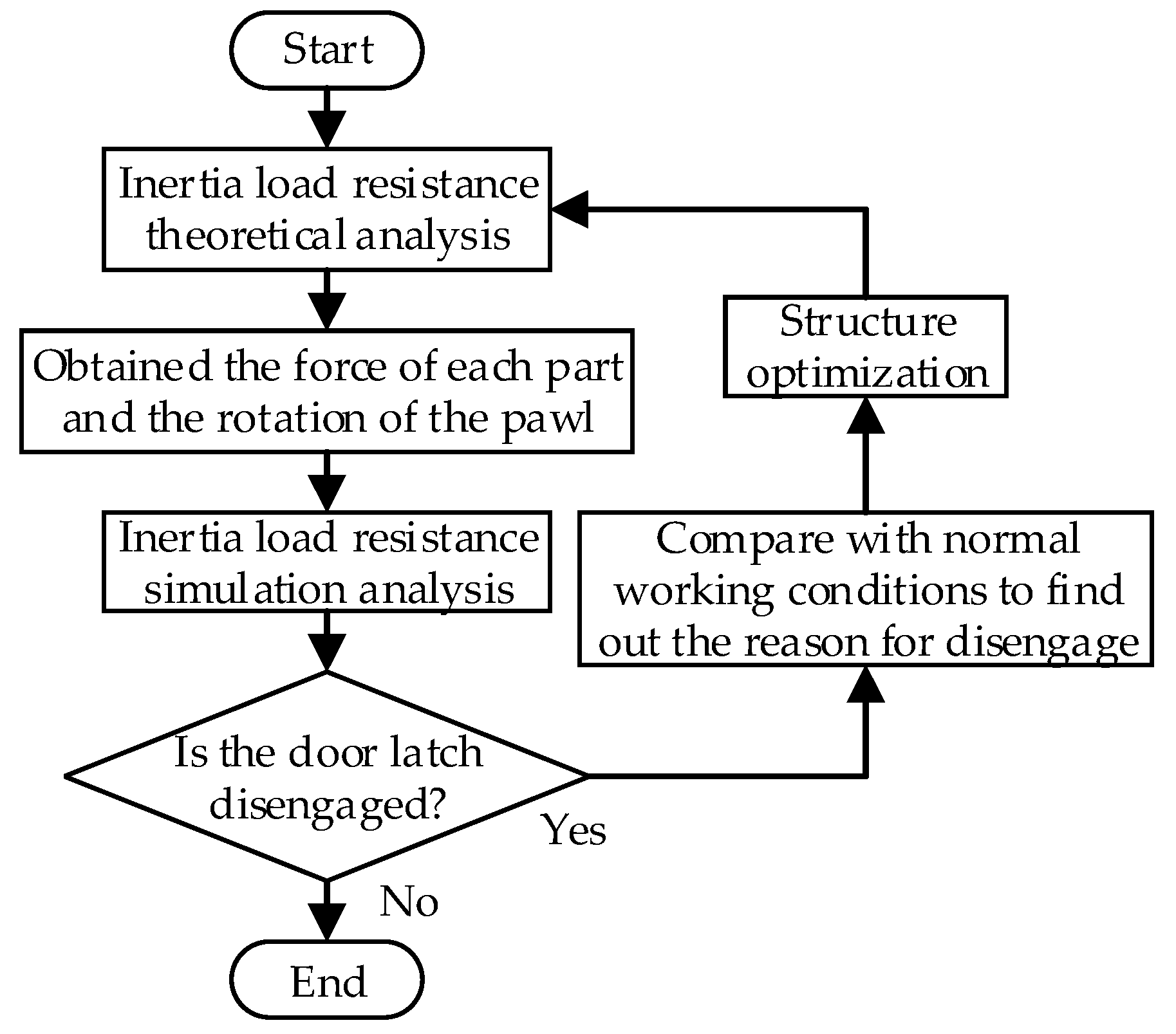

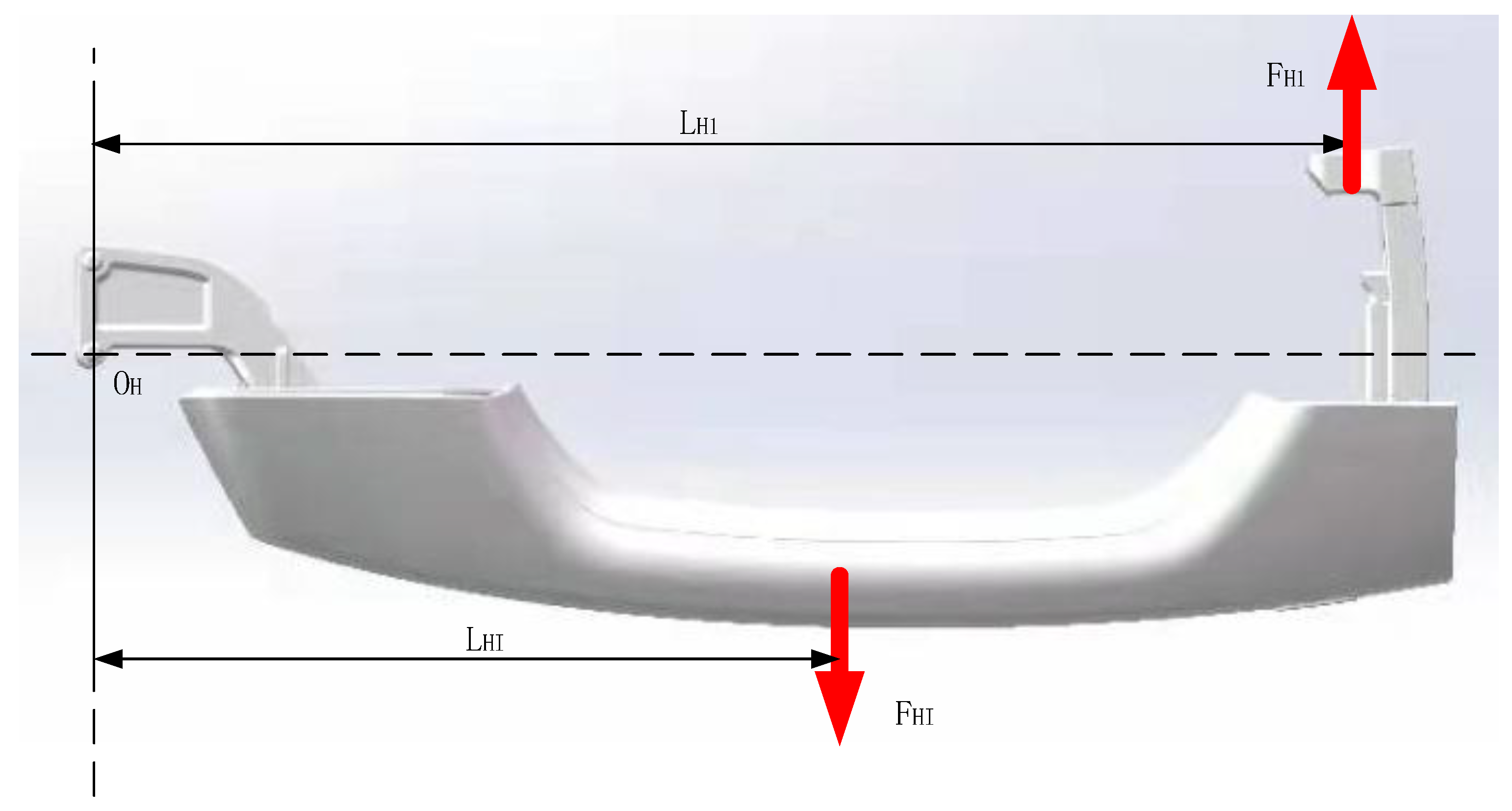
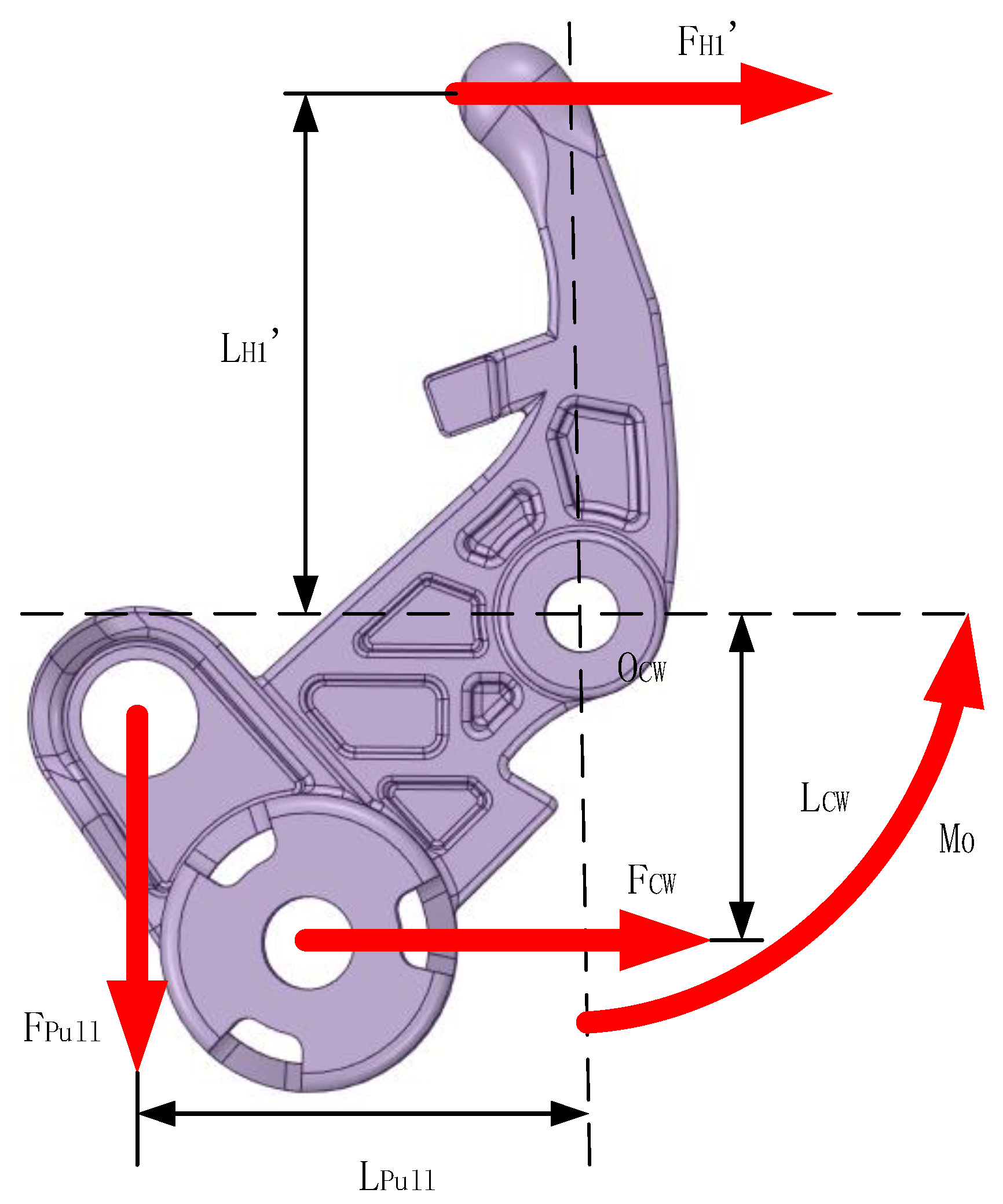
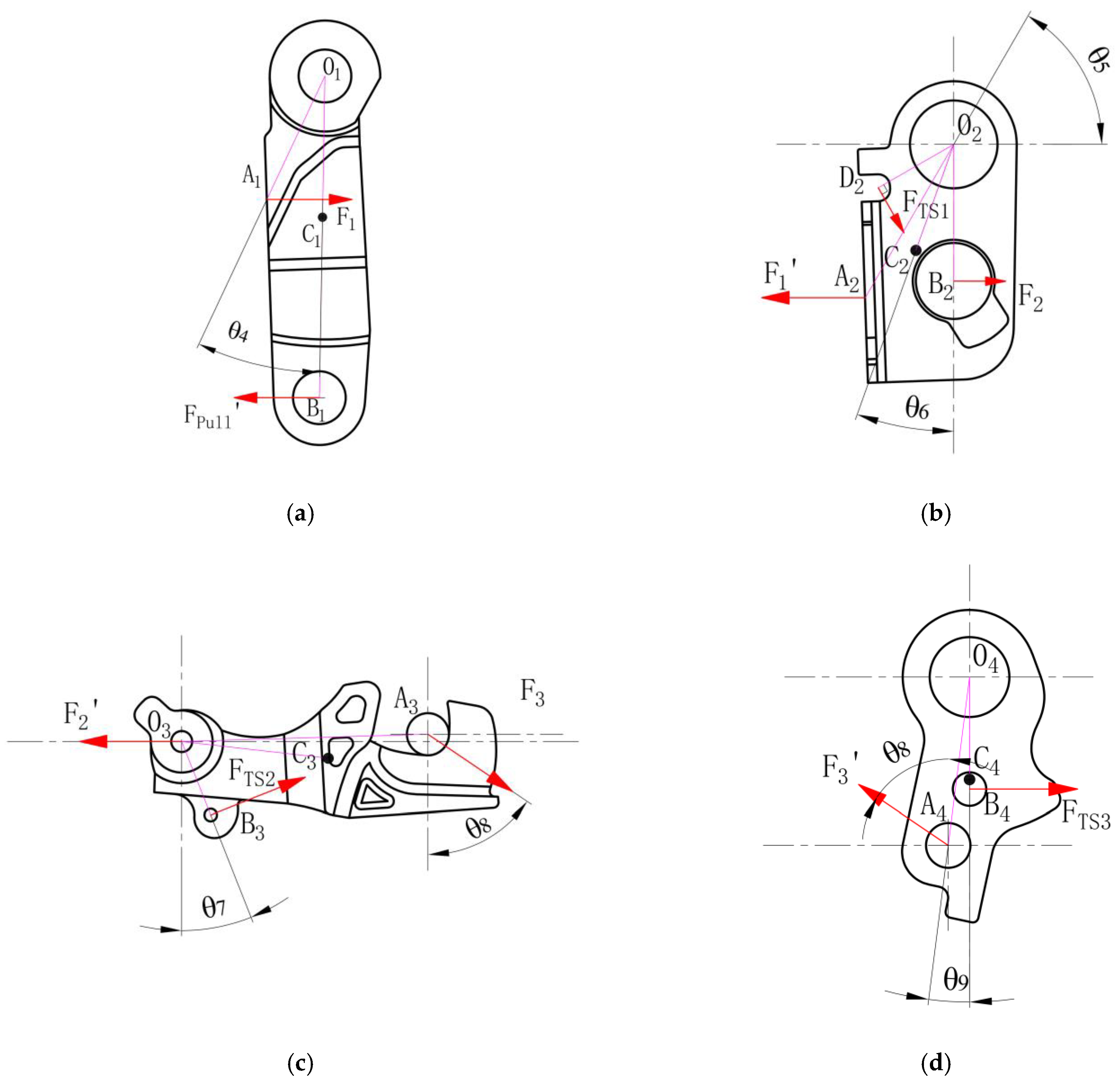
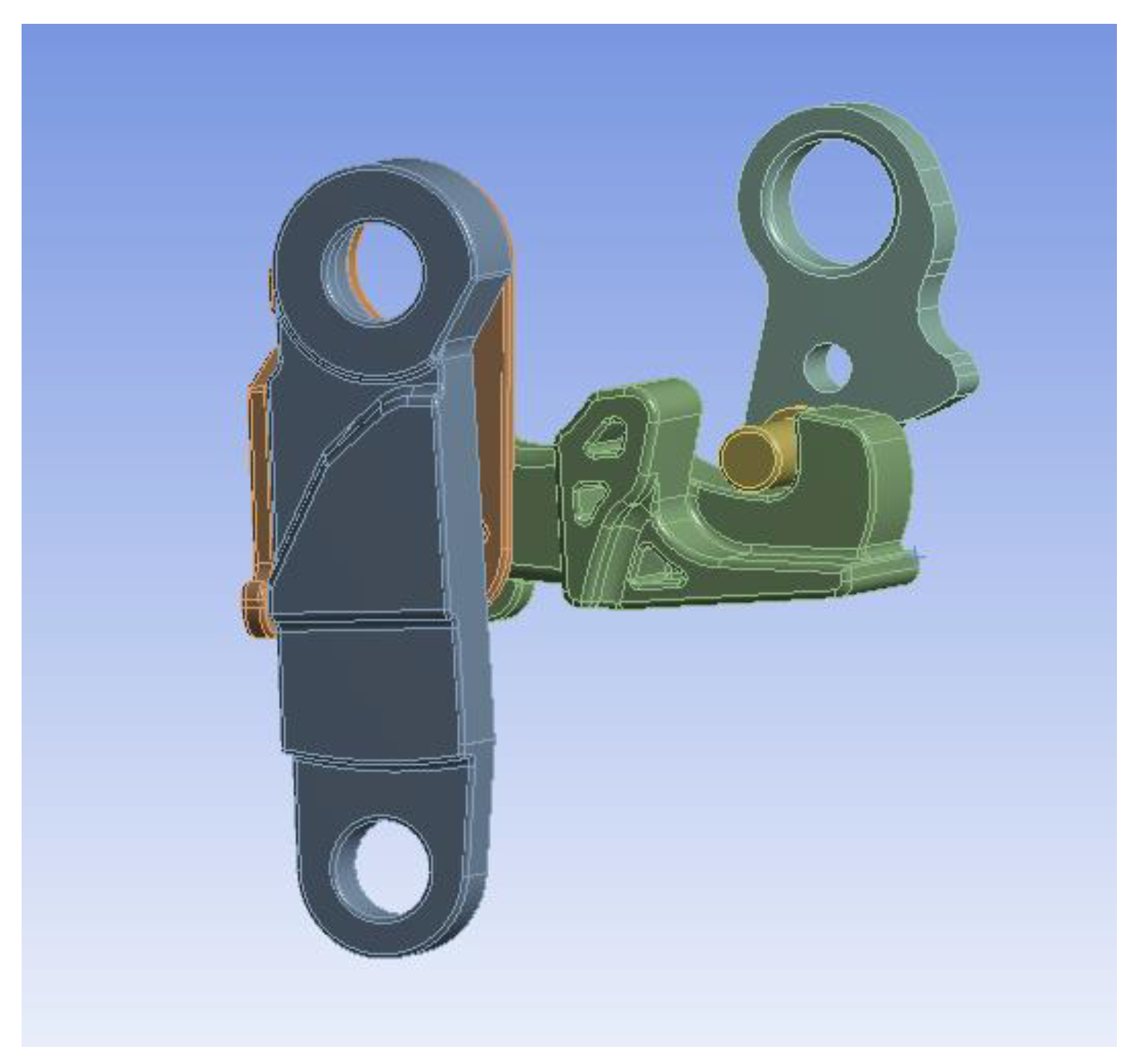

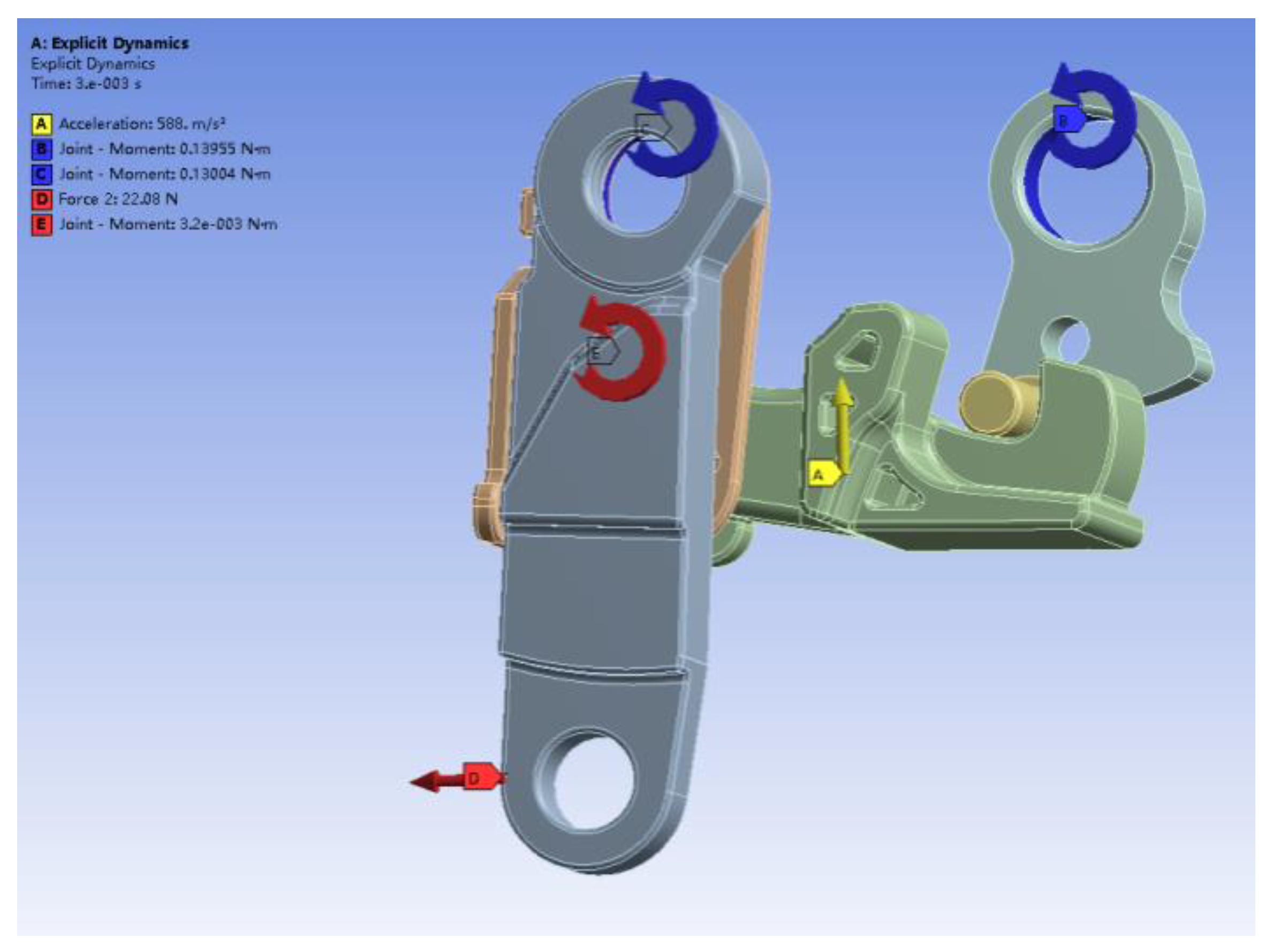
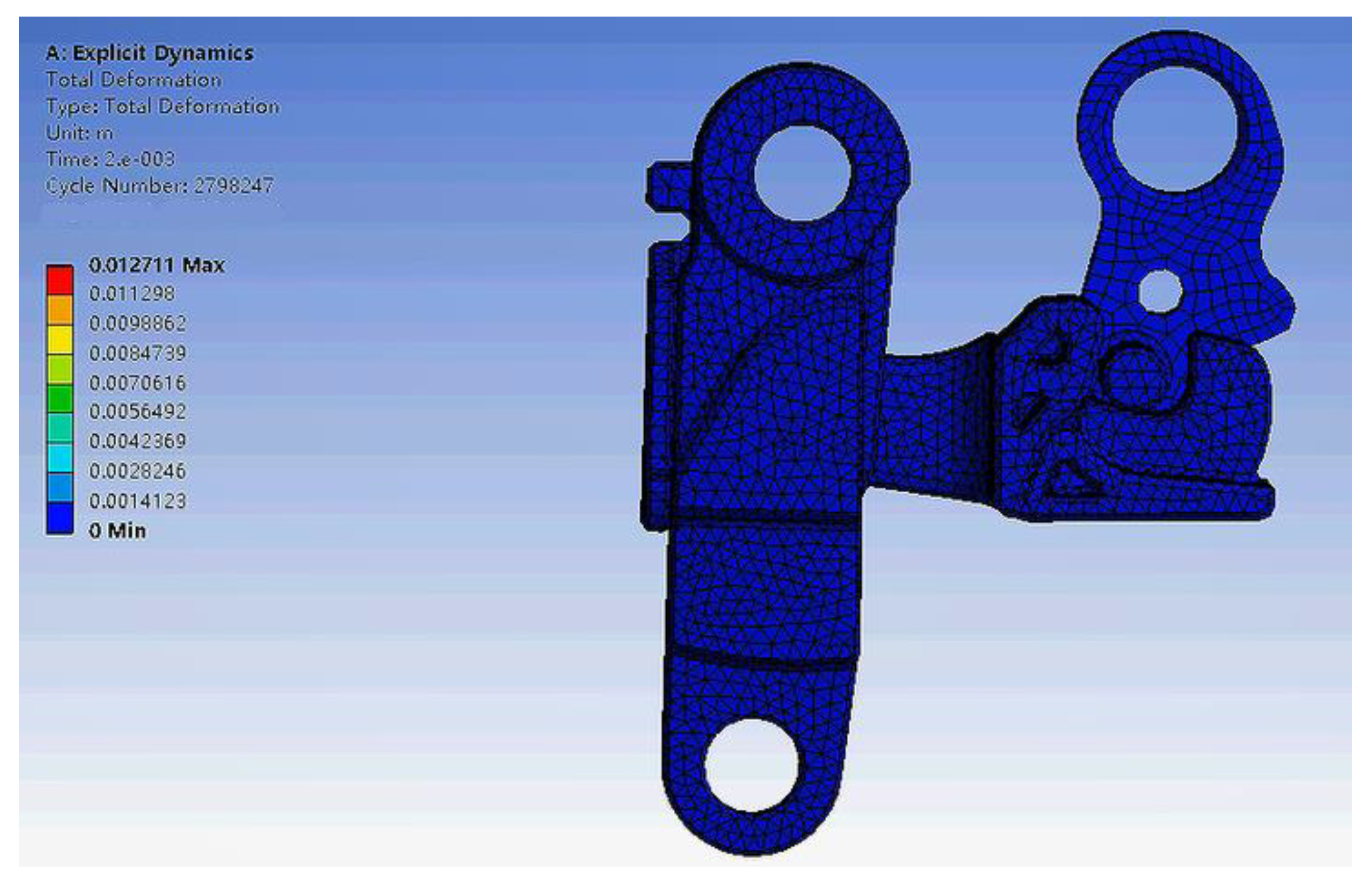


| Name | Wire Diameter/mm | Mean Coil Diameter/mm | Total Number of Coils | Material | Arm Length 1 /mm | Arm Length 2 /mm |
|---|---|---|---|---|---|---|
| Outside handle torsion spring | 1.7 | 11.5 | 8.25 | 65 Mn | 12 | 12 |
| Opening connect arm torsion spring | 1.2 | 12 | 5.4 | 65 Mn | 23 | 5.6 |
| Lock return torsion spring | 0.8 | 7 | 3.55 | 65 Mn | 16.3 | 6.1 |
| Pawl torsion spring | 1.2 | 10.8 | 4.25 | 65 Mn | 17 | 8.4 |
| Name | Preload Torque/(N·mm) | Inertia Load Resistance Calculation Torque/(N·mm) | Torque When Fully Disengaged/(N·mm) |
|---|---|---|---|
| Outside handle torsion spring/M0 | − | − | 341.92 |
| Outside open torsion spring/M1 | 113.79 | 130.04 | 146.30 |
| Lock back torsion spring/M2 | 32.00 | − | − |
| Pawl torsion spring/M3 | 124.80 | 139.55 | 154.30 |
| Name | Volume/mm3 | Density (kg/m3) | Mass/g |
|---|---|---|---|
| Outside handle | - | - | 139 |
| Outside handle counterweight | - | 7860 | 70 |
| Outside open toggle arm | 2355 | 1370 | - |
| Opening connect arm | 540 | 7850 | - |
| Pawl connect arm | 2817.5 | 1370 | - |
| Pawl | 970 | 7850 | - |
| Arm | Length/(mm) | Arm | Length/(mm) |
|---|---|---|---|
| LHI | 123.37 | LH1 | 208.50 |
| LH1′ | 26.50 | LCW | 10.00 |
| LPull | 24.00 |
| Distance between Two Points | Length/(mm) | Distance between Two Points | Length/(mm) |
|---|---|---|---|
| LO1A1 | 15.50 | LO1C1 | 16.00 |
| LO1B1 | 36.00 | LO2A2 | 16.50 |
| LO2C2 | 10.50 | LO2C2 | 8.00 |
| LO2B2 | 12.75 | LO3B3 | 7.50 |
| LO3A3 | 23.50 | LO3C3 | 14.00 |
| LO4A4 | 15.00 | LO4B4 | 10.00 |
| LO4C4 | 9.15 |
| Working Condition | Force/Torque | Calculation Results | Force | Calculation Results |
|---|---|---|---|---|
| 60 g side impact load | FPull | 22.08 N | F1 | 56.26 N |
| F2 | 52.11 N | F3 | 56.20 N | |
| MT | 826.66 N·mm | |||
| Normal opening condition | FPull | 6.02 N | F1 | 15.10 N |
| F2 | 5.98 N | F3 | 10.66 N | |
| MT | 139.82 N·mm |
| Material | Density/(kg/m3) | Young’s Modulus/(MPa) | Poisson’s Ratio |
|---|---|---|---|
| PA6 + 30%GF | 1370 | 1 × 105 | 0.35 |
| 35CrMo | 7900 | 2.13 × 105 | 0.286 |
| DC01 | 7850 | 2.06 × 105 | 0.32 |
Publisher’s Note: MDPI stays neutral with regard to jurisdictional claims in published maps and institutional affiliations. |
© 2022 by the authors. Licensee MDPI, Basel, Switzerland. This article is an open access article distributed under the terms and conditions of the Creative Commons Attribution (CC BY) license (https://creativecommons.org/licenses/by/4.0/).
Share and Cite
Hu, J.; Xu, L.; Guo, S.; Sun, Y.; Li, G. Study on Inertia Load Resistance Analysis Method of Light Truck Door Latch. Appl. Sci. 2022, 12, 4171. https://doi.org/10.3390/app12094171
Hu J, Xu L, Guo S, Sun Y, Li G. Study on Inertia Load Resistance Analysis Method of Light Truck Door Latch. Applied Sciences. 2022; 12(9):4171. https://doi.org/10.3390/app12094171
Chicago/Turabian StyleHu, Jian, Lei Xu, Sangdu Guo, Yiming Sun, and Gangyan Li. 2022. "Study on Inertia Load Resistance Analysis Method of Light Truck Door Latch" Applied Sciences 12, no. 9: 4171. https://doi.org/10.3390/app12094171
APA StyleHu, J., Xu, L., Guo, S., Sun, Y., & Li, G. (2022). Study on Inertia Load Resistance Analysis Method of Light Truck Door Latch. Applied Sciences, 12(9), 4171. https://doi.org/10.3390/app12094171







